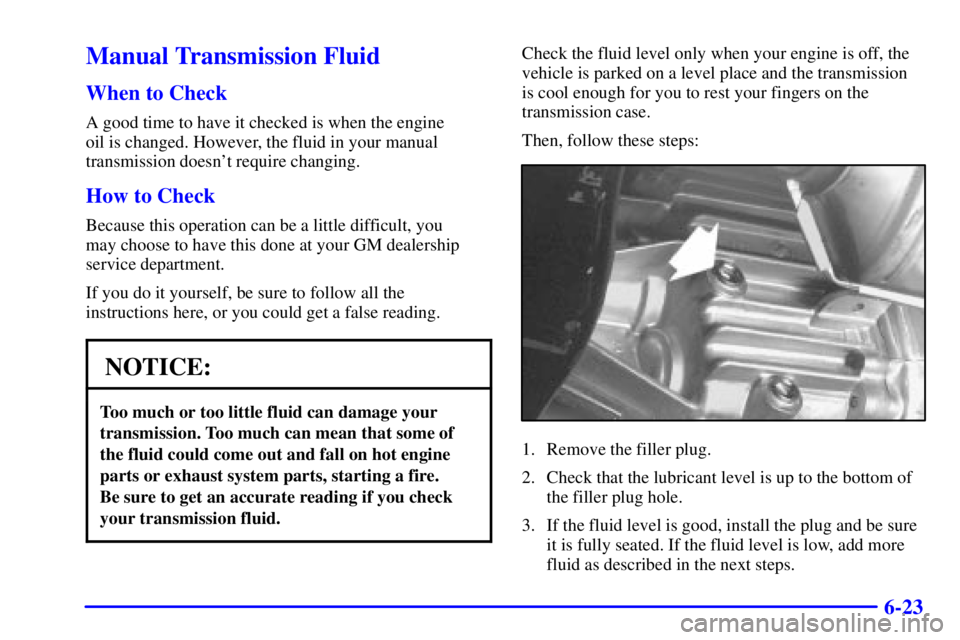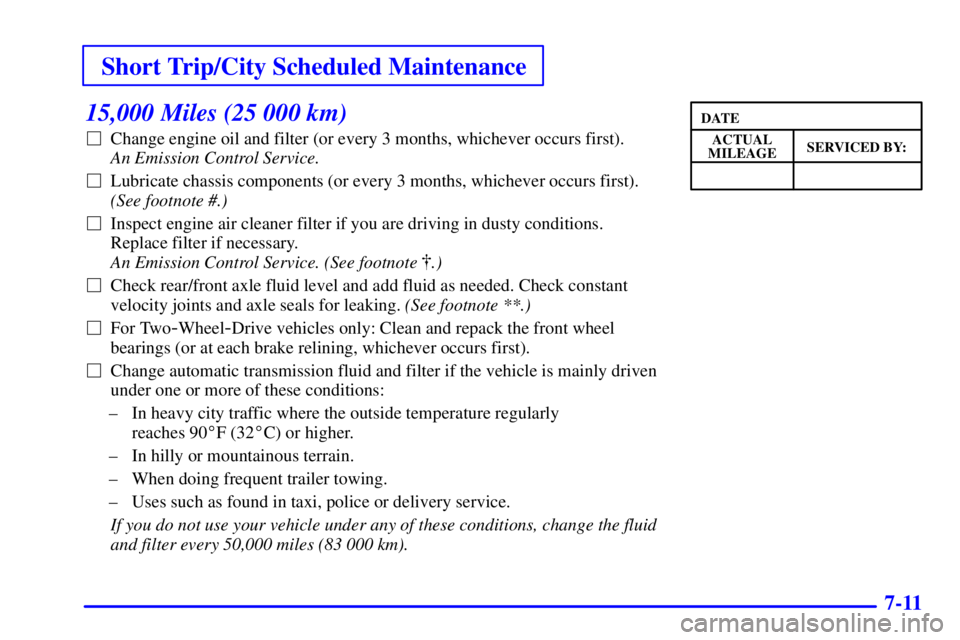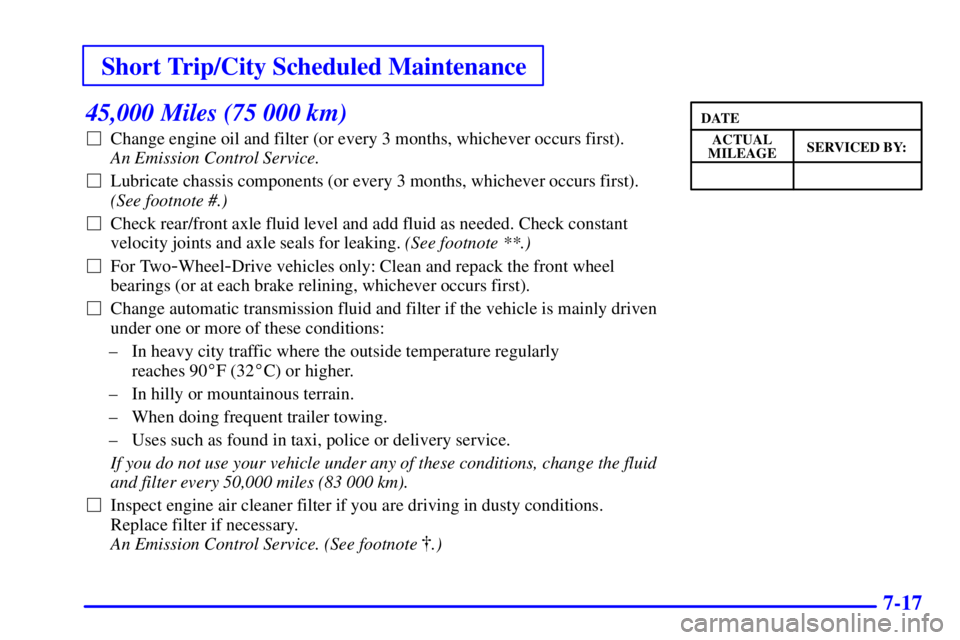Page 285 of 407

6-20 How to Check
Because this operation can be a little difficult, you may
choose to have this done at the dealership service department.
If you do it yourself, be sure to follow all the instructions
here, or you could get a false reading on the dipstick.
NOTICE:
Too much or too little fluid can damage your
transmission. Too much can mean that some of
the fluid could come out and fall on hot engine
parts or exhaust system parts, starting a fire.
Be sure to get an accurate reading if you check
your transmission fluid.
Wait at least 30 minutes before checking the
transmission fluid level if you have been driving:
�When outside temperatures are above 90�F (32�C).
�At high speed for quite a while.
�In heavy traffic
-- especially in hot weather.
�While pulling a trailer.To get the right reading, the fluid should be at
normal operating temperature, which is 180�F to
200�F (82�C to 93�C).
Get the vehicle warmed up by driving about 15 miles
(24 km) when outside temperatures are above 50�F
(10�C). If it's colder than 50�F (10�C), drive the
vehicle in THIRD (3) until the engine temperature gage
moves and then remains steady for 10 minutes.
A cold fluid check can be made after the vehicle has
been sitting for eight hours or more with the engine off,
but this is used only as a reference. Let the engine run
at idle for five minutes if outside temperatures are 50�F
(10�C) or more. If it's colder than 50�F (10�C),
you may have to idle the engine longer. Should the fluid
level be low during this cold check, you must check the
fluid hot before adding fluid. Checking the fluid hot will
give you a more accurate reading of the fluid level.
Page 286 of 407
6-21
Checking the Fluid Level
Prepare your vehicle as follows:
�Park your vehicle on a level place.
Keep the engine running.
�With the parking brake applied, place the shift lever
in PARK (P).
�With your foot on the brake pedal, move the shift
lever through each gear range, pausing for about
three seconds in each range. Then, position the shift
lever in PARK (P).
�Let the engine run at idle for three minutes or more.Then, without shutting off the engine, follow these steps:
The transmission dipstick
is located near the center
of the engine compartment.
See ªEngine Compartment
Overviewº in the Index
for more information
on location.
1. Flip the handle up and then pull out the dipstick and
wipe it with a clean rag or paper towel.
2. Push it back in all the way, wait three seconds and
then pull it back out again.
Page 287 of 407

6-22
3. Check both sides of the dipstick, and read the lower
level. The fluid level must be in the COLD area,
below the cross
-hatched area, for a cold check or in
the HOT area or cross
-hatched area for a hot check.
4. If the fluid level is in the acceptable range, push the
dipstick back in all the way; then flip the handle
down to lock the dipstick in place.
How to Add Fluid
Refer to the Maintenance Schedule to determine what
kind of transmission fluid to use. See ªRecommended
Fluids and Lubricantsº in the Index.
Add fluid only after checking the transmission fluid
while it is hot. (A cold check is used only as a
reference.) If the fluid level is low, add only enough of
the proper fluid to bring the level up to the HOT area for
a hot check. It doesn't take much fluid, generally less
than one pint (0.5 L). Don't overfill.
NOTICE:
We recommend you use only fluid labeled
DEXRON�-III, because fluid with that label is
made especially for your automatic transmission.
Damage caused by fluid other than DEXRON
�-III
is not covered by your new vehicle warranty.
�After adding fluid, recheck the fluid level as
described under ªHow to Check.º
�When the correct fluid level is obtained, push the
dipstick back in all the way; then flip the handle
down to lock the dipstick in place.
Page 288 of 407

6-23
Manual Transmission Fluid
When to Check
A good time to have it checked is when the engine
oil is changed. However, the fluid in your manual
transmission doesn't require changing.
How to Check
Because this operation can be a little difficult, you
may choose to have this done at your GM dealership
service department.
If you do it yourself, be sure to follow all the
instructions here, or you could get a false reading.
NOTICE:
Too much or too little fluid can damage your
transmission. Too much can mean that some of
the fluid could come out and fall on hot engine
parts or exhaust system parts, starting a fire.
Be sure to get an accurate reading if you check
your transmission fluid.
Check the fluid level only when your engine is off, the
vehicle is parked on a level place and the transmission
is cool enough for you to rest your fingers on the
transmission case.
Then, follow these steps:
1. Remove the filler plug.
2. Check that the lubricant level is up to the bottom of
the filler plug hole.
3. If the fluid level is good, install the plug and be sure
it is fully seated. If the fluid level is low, add more
fluid as described in the next steps.
Page 335 of 407

6-70
Capacities and Specifications
Please refer to ªRecommended Fluids and Lubricantsº
in the index for more information. See refrigerant
change label under the hood for charge capacity
information and requirements.
Wheel Nut Torque100 lb
-ft (140 N´m) . . . . . . . . . .
Tire PressureSee the Certification/Tire . . . . . . . . . . .
label. See ªLoading Your Vehicleº in the Index.
Cooling System*
2.2L Engine 9.9 quarts (9.4 L). . . . . . . . . . . . . . . . . .
4.3L Engine w/Auto. Trans. 13.8 quarts (13.1 L). . . .
4.3L Engine w/Manual. Trans. 14.1 quarts (13.3 L). .
Engine Crankcase
- Oil and Filter Change*
2.2L Engine 4.5 quarts (4.3 L). . . . . . . . . . . . . . . . . .
4.3L Engine 4.5 quarts (4.3 L). . . . . . . . . . . . . . . . . . Fuel Capacity
Reg./Ext. Cab 18.5 U.S. Gallons (70.0 L). . . . . . . . . .
Crew Cab 19.0 U.S. Gallons (71.9 L). . . . . . . . . . . . .
Automatic Transmission*
Drain and Refill 5.0 quarts (4.7 L). . . . . . . . . . . . . . .
Differential Fluid
Rear Axle 4.0 pints (1.9 L). . . . . . . . . . . . . . . . . . . . .
Front Axle 2.6 pints (1.2 L). . . . . . . . . . . . . . . . . . . .
Refrigerant, Air ConditioningSee Refrigerant . . .
Label under the hood.
*After refill, the level must be checked.
All capacities are approximate. When adding, be sure to
fill to the appropriate level or as recommended in this
manual. See ªRecommended Fluids and Lubricantsº in
the Index.
Page 349 of 407

Short Trip/City Scheduled Maintenance
7-11
15,000 Miles (25 000 km)
�Change engine oil and filter (or every 3 months, whichever occurs first).
An Emission Control Service.
�Lubricate chassis components (or every 3 months, whichever occurs first).
(See footnote #.)
�Inspect engine air cleaner filter if you are driving in dusty conditions.
Replace filter if necessary.
An Emission Control Service. (See footnote �.)
�Check rear/front axle fluid level and add fluid as needed. Check constant
velocity joints and axle seals for leaking. (See footnote **.)
�For Two
-Wheel-Drive vehicles only: Clean and repack the front wheel
bearings (or at each brake relining, whichever occurs first).
�Change automatic transmission fluid and filter if the vehicle is mainly driven
under one or more of these conditions:
± In heavy city traffic where the outside temperature regularly
reaches 90�F (32�C) or higher.
± In hilly or mountainous terrain.
± When doing frequent trailer towing.
± Uses such as found in taxi, police or delivery service.
If you do not use your vehicle under any of these conditions, change the fluid
and filter every 50,000 miles (83 000 km).
ACTUAL
SERVICED BY:MILEAGE
DATE
Page 352 of 407
Short Trip/City Scheduled Maintenance
7-14
30,000 Miles (50 000 km) (Continued)
�For Two
-Wheel-Drive vehicles only: Clean and repack the front wheel
bearings (or at each brake relining, whichever occurs first).
�4.3L V6 Engine Only: Replace fuel filter.
An Emission Control Service. (See footnote �.)
�Replace engine air cleaner filter.
An Emission Control Service.
�Change automatic transmission fluid and filter if the vehicle is mainly driven
under one or more of these conditions:
± In heavy city traffic where the outside temperature regularly
reaches 90�F (32�C) or higher.
± In hilly or mountainous terrain.
± When doing frequent trailer towing.
± Uses such as found in taxi, police or delivery service.
If you do not use your vehicle under any of these conditions, change the fluid
and filter every 50,000 miles (83 000 km).
�Rotate tires. See ªTire Inspection and Rotationº in the Index for proper
rotation pattern and additional information. (See footnote +.)
Page 355 of 407

Short Trip/City Scheduled Maintenance
7-17
45,000 Miles (75 000 km)
�Change engine oil and filter (or every 3 months, whichever occurs first).
An Emission Control Service.
�Lubricate chassis components (or every 3 months, whichever occurs first).
(See footnote #.)
�Check rear/front axle fluid level and add fluid as needed. Check constant
velocity joints and axle seals for leaking. (See footnote **.)
�For Two
-Wheel-Drive vehicles only: Clean and repack the front wheel
bearings (or at each brake relining, whichever occurs first).
�Change automatic transmission fluid and filter if the vehicle is mainly driven
under one or more of these conditions:
± In heavy city traffic where the outside temperature regularly
reaches 90�F (32�C) or higher.
± In hilly or mountainous terrain.
± When doing frequent trailer towing.
± Uses such as found in taxi, police or delivery service.
If you do not use your vehicle under any of these conditions, change the fluid
and filter every 50,000 miles (83 000 km).
�Inspect engine air cleaner filter if you are driving in dusty conditions.
Replace filter if necessary.
An Emission Control Service. (See footnote �.)
ACTUAL
SERVICED BY:MILEAGE
DATE